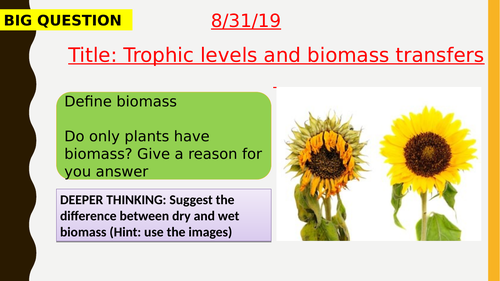

Please note that I have merged the content of two lessons into one resource.
Trophic levels and biomass transfers lesson created in accordance to the NEW AQA Specification (9-1). Designed for a higher ability class, although content can be adjusted to suit any ability. This lesson Includes powerpoint timers, slide animations, past paper questions, self-assessment, interactive mark scheme, embedded videos and review.
For general enquiries or support please email: Paperfriendlyresources@gmail.com
NB: If you are unable to play embedded videos please view slide notes for link. *
AQA spec link: 4.7.4; 1, 2, 3
Relevant chapter: B18 Biodiversity and ecosystems. AQA Biology third edition textbook-Page 300-301
Students are required to know the following;
7.4.1 Students should be able to describe the differences between the trophic levels of organisms within an ecosystem.
Trophic levels can be represented by numbers, starting at level 1 with plants and algae. Further trophic levels are numbered subsequently according to how far the organism is along the food chain.
Level 1: Plants and algae make their own food and are called producers.
Level 2: Herbivores eat plants/algae and are called primary consumers.
Level 3: Carnivores that eat herbivores are called secondary consumers.
Level 4: Carnivores that eat other carnivores are called tertiary consumers. Apex predators are carnivores with no predators.
Decomposers break down dead plant and animal matter by secreting enzymes into the environment. Small soluble food molecules then diffuse into the microorganism.
7.4.2 Pyramids of biomass can be constructed to represent the relative amount of biomass in each level of a food chain.
Trophic level 1 is at the bottom of the pyramid.
Students should be able to construct accurate pyramids of biomass from appropriate data.
7.4.3 Students should be able to: • describe pyramids of biomass • explain how biomass is lost between the different trophic levels.
Producers are mostly plants and algae which transfer about 1% of the incident energy from light for photosynthesis.
Only approximately 10% of the biomass from each trophic level is transferred to the level above it.
Losses of biomass are due to:
• not all the ingested material is absorbed, some is egested as faeces
• some absorbed material is lost as waste, such as carbon dioxide and water in respiration and water and urea in urine.
Large amounts of glucose are used in respiration.
Students should be able to calculate the efficiency of biomass transfers between trophic levels by percentages or fractions of mass.
Students should be able to explain how this affects the number of organisms at each trophic level.
Get this resource as part of a bundle and save up to 24%
A bundle is a package of resources grouped together to teach a particular topic, or a series of lessons, in one place.
Something went wrong, please try again later.
This resource hasn't been reviewed yet
To ensure quality for our reviews, only customers who have purchased this resource can review it
Report this resourceto let us know if it violates our terms and conditions.
Our customer service team will review your report and will be in touch.
